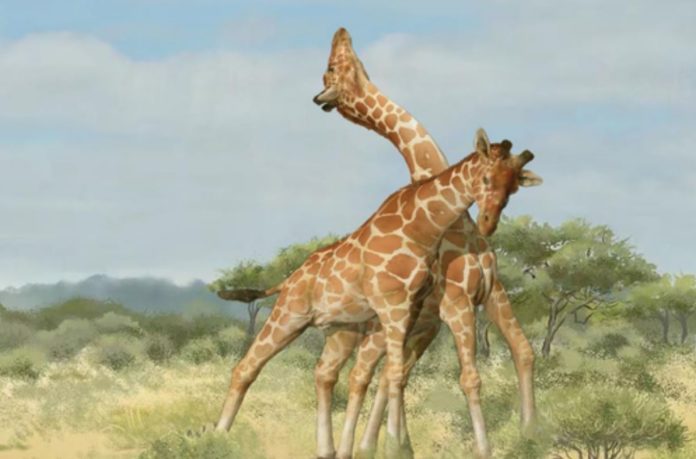How the long neck of the giraffe evolved has been a mystery for a long time. Although there have been differing viewpoints on the process of giraffe neck elongation, experts have never denied that abundant foliage is the driving force behind neck elongation.
A research team from the Institute of Vertebrate Paleontology and Paleoanthropology (IVPP) of the Chinese Academy of Sciences led a study that looked at the fossils of a strange early giraffoid to find out how giraffes evolved.
The report was published today in Science.
How the long neck of the giraffe evolved has been a mystery for a long time. Although there have been differing viewpoints on the process of giraffe neck elongation, experts have never denied that abundant foliage is the driving force behind neck elongation.
However, as more giraffe behavior was observed, scientists realized that the graceful, long neck of giraffes is used as a weapon in male courtship competition, which could be the key to solving the giraffe evolutionary enigma.
Specifically, giraffes utilize their two- to three-meter-long swaying necks to hurl their hefty skulls — which are endowed with tiny ossicones and osteomas — at the weaker sections of rivals. This means that longer necks result in more damage to their opponents. Consequently.
The investigation was carried out by IVPP researchers and partners on Discokeryx xiezhi, a bizarre early giraffoid. This study helps to explain how the giraffe’s long neck originated, as well as the thorough integration of courtship difficulties and food demands. In reality, the length of a male giraffe’s neck is proportional to his social standing, and courtship competition is the driving factor behind the evolution of long necks.
The fossils in this study were found in layers from the early Miocene, which happened about 17 million years ago. These layers were found on the northern edge of the Junggar Basin in Xinjiang. The discovery included a whole skull and four cervical vertebrae.
“Discokeryx xiezhi featured many unique characteristics among mammals, including the development of a disc-like large ossicone in the middle of its head,” says corresponding author Prof. DENG Tao from IVPP. According to DENG, the solitary ossicone resembles that of the xiezhi, a one-horned beast from ancient Chinese mythology; hence, the fossil was given the name xiezhi.
The cervical vertebrae of Discokeryx xiezhi are unusually thick, according to the experts, and contain the most complicated joints between head and neck and between cervical vertebrae of any animal. The team showed that the complex joints between the skull and cervical vertebrae of Discokeryx xiezhi were especially suited to high-speed head-to-head impacts. They discovered that this structure was significantly more effective than that of existing species that are specialized to head impact, such as musk oxen. Discokeryx xiezhi, in fact, may have been the best-adapted vertebrate to head impact ever.
“Both living giraffes and Discokeryx xiezhi belong to the Giraffoidea, a superfamily. Although their skull and neck morphologies differ greatly, both are associated with male courtship struggles and both have evolved in an extreme direction,” adds WANG Shiqi, the study’s first author.
The researchers compared the horn morphology of giraffoids, cattle, sheep, deer, and pronghorns, among other ruminants. They discovered that giraffe horn diversity is substantially higher than in other ruminant species, with a tendency toward dramatic morphological variances, implying that giraffe courtship fights are more intense and diverse than in other ruminants.
The ecological habitat of Discokeryx xiezhi and the niche it occupies were also studied by the researchers. The Earth was warm and densely forested, but the Xinjiang region, where Discokeryx xiezhi thrived, was slightly drier than other locations because the Tibetan Plateau to the south had been rising quickly, impeding water vapor transport.
“Stable isotopes of tooth enamel have indicated that Discokeryx xiezhi was living in open grasslands and may have migrated seasonall,” says MENG Jin, another study co-author. The grassland environment was more desolate and uncomfortable for animals at the time than the woodland environment. The survival-related stress induced by the environment may have influenced Discokeryx xiezhi’s violent fighting habit.
At the start of the evolution of the genus Giraffa, the environment was the same. Around seven million years ago, the East African Plateau transitioned from a forested to an open grassland ecosystem, forcing giraffes’ direct ancestors to adapt to new conditions. Mating males may have developed a method of fighting their opponents by swinging their necks and heads among giraffe relatives during this time. Over the course of two million years, this severe battle, aided by sexual selection, resulted in the fast extension of the giraffe’s neck, resulting in the modern genus, Giraffa.
Giraffa were well-suited for the niche of eating on high leaves because of their elongation. Their ecological standing, on the other hand, was inherently less solid than that of bovids and cervids. As a result of Giraffa’s marginal ecological niche, high intraspecific courtship competition may have favored dramatic morphological evolution.
Image Credit: Getty
You were reading: New Study Solves Mystery Of Strange Early Giraffoid – Now’s Giraffe
